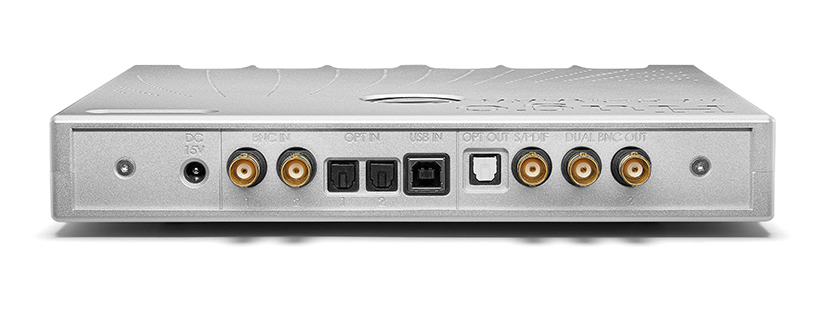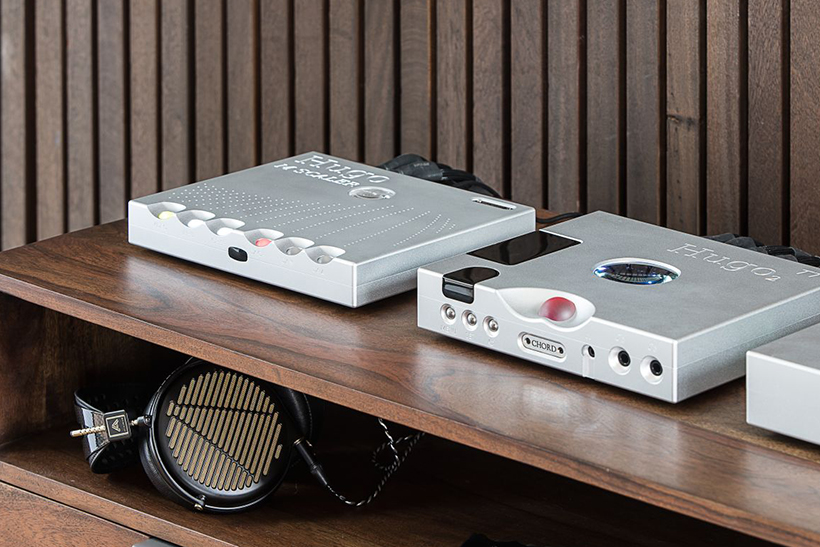I was afforded the opportunity this summer to get up close and personal with not one but two of Chord Electronics’ latest creations, the Hugo TT 2 DAC/headphone amp and Hugo M Scaler. With extensive input from experienced digital design consultant Rob Watts, both British-built products promise to set new standards in home audio, and I was only too happy to put this claim to the test.
Previously exclusive to Chord Electronics’ £8k Blu mkII CD transport, Rob Watts’ groundbreaking million-tap WTA upsampling filter, M Scaler, is now available to a much wider audience in standalone form. Priced at £3,495 and available in silver or black with a form factor that matches Hugo TT 2, the aptly-named Hugo M Scaler is the realisation of a 35-year ambition for accurate reconstruction of 44.1kHz 16-bit PCM audio.
Sampling theory
Many in the audio industry, especially Watts, believe that transients are a critical aspect of the perception of music, and that the ear/brain is very sensitive to extremely small timing errors. It is argued that such errors not only smear the starting and stopping of notes, but also degrade the ability to perceive instrument timbre and power as well as the precision of the soundstage.

Watts’ unique approach to digital-to-analogue conversion is inspired by the implications of Shannon’s sampling theorem. A Whittaker-Shannon interpolation filter perfectly reconstructs the original, continuous analogue signal from sampled digital data with zero transient timing errors, but needs a sinc impulse response to do so. A sinc impulse response however requires an infinite coefficient or ‘tap’ length, infinitely oversampled FIR filter; something that does not exist in practice.
Watts posits that conventional DACs are poor at reproducing the original continuous analogue signal and cause audible transient timing errors because they typically use only a few hundred taps. He, by comparison, predicted in the early 1980s that a filter with around one million taps would be required for full 16-bit interpolation accuracy. Such tap lengths were of course inconceivable back then, and remained so until only recently when the Xilinx XC7A200T FPGA became available, its 740 DSP cores allowing a total of more than one million taps to be accessed.
WTA filter
With its million taps the Hugo M Scaler positively dwarfs all of Chord’s other DAC filters. Even the mighty DAVE begins to look rather humble with just 1/6th of M Scaler’s tap facility. It’s only natural therefore to wonder if M Scaler effectively renders all of Chord’s filters with fewer coefficients inadequate? Not quite, every DAC Rob Watts has designed, from the 1,000-tap DAC 64 to the 164,000-tap DAVE, uses Watts Transient Alignment (WTA) algorithm to maximise timing reconstruction accuracy with that particular finite tap length and is, according to Watts, of even greater importance than the tap length itself. Owners can be therefore be confident the WTA filter in their existing Chord DAC is getting the most from whatever number of taps it has. That said, each previous boost in Chord’s filter coefficients has brought sonic benefits, so you would expect the latest leap to one million taps to be especially beneficial, if the theory is correct.
Connectivity
In case it isn’t already apparent, Hugo M Scaler is not a D/A converter, it is an upscaler that connects between source and DAC and performs a more accurate interpolation of sampled digital audio before sending it onto the DAC to complete the conversion to an analogue signal. The sonic improvements from ascending the Chord DAC hierarchy still therefore very much apply, with or without M Scaler.

M Scaler is equipped with total of five inputs: galvanically isolated USB, optical Toslink (x2) and SPDIF BNC coax (x2). Three outputs are provided: optical Toslink, SPDIF BNC coax and dual-BNC (DBNC) coax. The device is compatible with all Chord DACs and, in theory, non-Chord DACs, but the maximum achievable upsampling rate, and thus sound quality, depends on the method of output and the highest input sampling rate your DAC supports.
M Scaler has a 16fs oversampling filter, meaning it upscales a 44.1kHz or 48kHz PCM input to 705.6kHz or 768kHz. It also upscales high res audio, but the maximum sampling rate it can output is still limited to 705.6kHz/768kHz, which is inconsequential as I am not presently aware of any consumer DACs that can accept a PCM input greater than this. The maximum 705.6kHz/768kHz sampling frequencies can however only be output over M Scaler’s DBNC outputs, which requires pairing it to a Chord DAC with DBNC inputs (presently Qutest, Hugo TT 2 and DAVE). The SPDIF output is limited to 352.8kHz/384kHz, while Toslink is limited to 176.4kHz/192kHz. The chart below shows the upsampling possibilities for each output. Despite not being listed, I can confirm having tested it that DSD is supported up to x256, but it is upsampled to 705.6kHz PCM and outputted exclusively over DBNC.

I auditioned Hugo M Scaler through its USB input with a Mac Mini configured to output audio at its native sampling rate, giving the Chord device full control over the upscaling, and connected it to a Hugo TT 2 DAC via DBNC to unlock all of its one million taps and maximum 705.6kHz/768kHz upsampling rates.
User interface
M Scaler’s user interface is very similar to that of TT 2. It doesn’t have a display screen, but each of the six push buttons on the front panel are used to cycle through functions and are illuminated in polychrome to denote the current settings. The buttons can be accessed even when TT 2 is stacked on top of it, though all functions can also be controlled using the remote. As with Hugo TT 2, the ‘Input’ button cycles through M Scaler’s five inputs, while the currently inactive trio of DX buttons are awaiting the release of Chord’s (rumoured) digital power amps.
The ‘Video’ button activates an asymmetric interpolation filter to reduce latency time and make M Scaler usable with visual content. Due to the huge number of taps and associated processing demands, there is a 0.6 second lag between input and output when M Scaler is in normal (audio) mode, which evidently causes severe lip-sync issues with video. Engaging the video filter reduces this lag to just 0.1 seconds which minimises this problem and, to my surprise, sacrifices very little audio performance. The filter can be switched on and off manually or set to automatically engage whenever a 48kHz input is detected.

‘OP SR’ stands for output sample rate and this button sets M Scaler’s all-important upsampling multiplier. Illustrated in the chart above, red is ‘bypass mode’ and passes the audio at its original sample rate, green is 2x, blue is 4x and white is full 16x upsampling. The rates can be cycled while music is playing with just a short pause between each change, making it easy to compare the performance of the different multipliers.
Unparalleled realism
It’s easy to take for granted the incremental improvements in consumer DACs that continue to narrow the performance gap between digital and analogue replay. Every so often, however, a product comes to market that is a genuine step-change in redefining the boundaries or – perhaps more appropriately in the case of Hugo M Scaler – blurring the lines between analogue and digital to the extent that even the most ardent analogue purists have to sit up and take notice.
Hugo M Scaler liberates digital audio from most, if not all, of the artefacts I tend to make concessions for, subconsciously or otherwise. Paired with Hugo TT 2, music becomes purer, richer and more lifelike. It improves instruments’ focus and clarity by eliminating the grain and brittleness that is often cited as a cause of smear and fatigue. This makes it easier to follow the envelopes of individual notes, from their initial transients through to the ends of their reverb tails, and provides a more natural flow and dynamic response.
Instrument timbres have improved texture, contributing to a meatier and more convincing soundscape. The performance space is enlarged, but so too is the ability of the performers to fill this space, meaning musicians not only have more freedom to express themselves but are also able to maintain the coherence and impact of the ensemble as a whole. This aids their all-important capacity to evoke an emotional response from the listener. In fact, with Hugo M Scaler I find myself connecting to music on a deeper level than I thought possible from digital playback.
Harness the potential
Despite a growing collection of high res PCM and DSD, the bulk of my music library is still comprised of standard CD quality 16-bit 44.1kHz PCM, as I suspect is the case for most if not all our readers. Since standard res has more acute performance limitations to begin with, it is unsurprising that the largest gains through Hugo M Scaler are witnessed with 16-bit 44.1kHz sources. High res PCM does however still benefit significantly from Watts’ million-tap upsampling filter, as does DSD which compares favourably to being piped directly into Hugo TT 2, suggesting wins on all counts to my ears.

Perhaps most surprising, however, is M Scaler’s ability to elevate the sound quality of humble CD to a level that not only narrows the gap to, but in many cases matches or even exceeds, high res PCM that has not undergone Chord’s upscaling treatment. This is all the more remarkable when you realise that many of these CDs were encoded decades ago when digital sampling technology was still in its infancy. M Scaler effectively recalibrates your expectations of digital replay.
For both standard and high res, it should be noted that the benefits are most apparent when Hugo M Scaler is upscaling to its maximum 16FS, 705.6kHz/768kHz. As the upscaling multiplier is reduced towards the sampling rate of the input, so too is the extent of the improvement, even when outputting to a Chord DAC over DBNC. As a value proposition, M Scaler therefore becomes trickier to justify to those with systems that are unable to harness its full potential. For Chord’s Qutest, Hugo TT 2 and DAVE I view it as a no-brainer purchase. For Chord DACs without DBNC inputs and non-Chord DACs, I recommend an audition to determine if the improvement with your specific D/A converter warrants the investment.
Verdict
Reviewed with the Hugo TT 2 DAC the Hugo M Scaler is a game-changer, this formidable pairing will hold its own against any top end system it’s pitted against. Be warned though, it is incredibly difficult to go back to a life of listening to music without M Scaler, so I advise auditioning it with Hugo TT 2 only if you are prepared for the inevitability of both units coming home with you.


